Strategic Considerations for Greenhouse Positioning
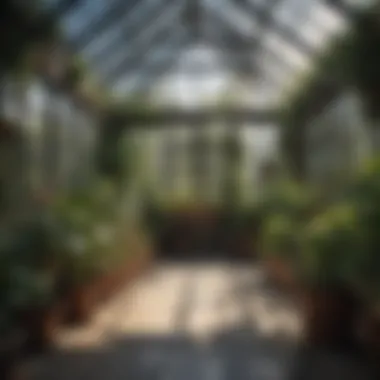

Intro
Positioning a greenhouse isn’t just a matter of plopping it down on a plot of land. It’s akin to orchestrating a symphony where harmony among various elements is essential for a flourishing result. This undertaking necessitates a keen eye on several components: environmental factors, site characteristics, and structural design echoing in the overarching aim of maximizing productivity. Homeowners and gardening aficionados need this insight to craft their green paradise effectively.
Design Inspirations
When it comes to designing a greenhouse, inspiration can be drawn from an array of styles and elements. The design of your greenhouse can blend functionality with aesthetics, making it not just a cultivation space but a striking addition to your garden.
Trending Styles
In today’s world, the allure of modernism holds sway in greenhouse designs. Investors often look at sleek, minimalist structures made from aluminum and glass as these materials provide not only durability but also an elegant look. On the other end of the spectrum, Victorian-style greenhouses, adorned with intricate wooden frames and ornate glass panels, can offer a nostalgic touch. Each style has its merits that resonate with personal taste and the surrounding environment.
- Modern Greenhouses: Focus on clean lines and functionality.
- Traditional Greenhouses: Often constructed from wood, harking back to past styles.
- Made from materials like aluminum, polycarbonate, or fiberglass for durability.
- Larger panes of glass can enhance light infiltration.
- Intricate carpentry can add character to the overall design.
- They can blend beautifully with natural landscapes.
Color Palettes
The color you choose for your greenhouse should not be an afterthought. It impacts both the structure’s visibility and how it interacts with the natural world. Neutral tones—like soft greens, grays, or earthy browns—often meld seamlessly into the garden setting. Conversely, brighter hues can serve as a bold statement, drawing the eyes across an otherwise green backdrop. Consider also the psychological impact of colors:
- Green conveys growth and tranquility.
- Blue promotes calmness and tends to reflect light well.
- Yellow stands out and can evoke feelings of warmth and cheerfulness.
Maintenance and Upkeep
Once the ideal greenhouse is in place, it’s crutial to consider maintenance. Just because it’s built doesn’t mean it's self-sustaining; great efforts can ensure its longevity and efficacy.
Seasonal Maintenance Checklist
To keep your greenhouse thriving, seasonal tasks should be on your radar:
- Spring: Check for leaks, clean the glass, and ensure ventilation openings are functioning.
- Summer: Monitor for pest invasions and apply shading if necessary to prevent overheating.
- Fall: Clear out old plants and debris, check for cracked panels or frames.
- Winter: Insulate where needed, and clear snow accumulation on roofs to prevent damage.
Cleaning and Organization Tips
An organized greenhouse performs better. Consider the following practices:
- Shelving Systems: Use adjustable shelves for flexible space management.
- Categorized Storage: Group tools and supplies by their functions.
- Regular Cleaning: A routine clean prevents mold and pest infestations.
"An organized space benefits not just the plants but also the gardener's productivity and peace of mind."
By meticulously addressing these strategic factors, greenhouse positioning and maintenance evolve from mere tasks into a form of art. The end result is not just a sheltered plot for plants but a curated sanctuary that nurtures growth and creativity.
Understanding the Importance of Greenhouse Positioning
Positioning a greenhouse is not merely about finding a spot to erect a structure; it’s a careful orchestration of various elements that synergistically contribute to a thriving environment for plants. When we talk about greenhouse positioning, we focus on how the selected site can significantly affect plant vitality, growth rates, and overall health.
The interplay between the greenhouse’s location and environmental factors can’t be overstated. From sunlight exposure to wind direction, each variable has a direct bearing on the internal climate of the greenhouse, thus impacting what you can grow and how well you can grow it. Getting it right isn’t just about aesthetics; it’s about functionality and maximizing yield.
More importantly, effective positioning can lead to energy savings, minimizing the need for artificial heating or cooling. The strategic placement of a greenhouse can insulate plants from harsh weather while making the best use of available natural resources. Therefore, understanding the nuances of greenhouse positioning is not only fundamental but essential for anyone aiming to cultivate plants successfully and sustainably.
Impacts on Plant Growth and Health
The location of your greenhouse can make or break your gardening endeavors. Plants are sensitive to their surroundings, and their growth patterns are intricately linked to their environment. For instance, if a greenhouse is sited in a shadowy spot, frequent exposure to low light will stunt growth and result in weak, leggy plants.
Conversely, placing the greenhouse in direct sunlight can encourage healthy growth, but too much sun without adequate ventilation might lead to scorching and wilting. You need to find that sweet spot where the sunlight is abundant yet manageable.
An effective approach is to use methods like
- Seasonal sun mapping: Track how sunlight moves through the seasons. This creates awareness about natural light patterns, providing insight on the best positioning.
- Microclimate awareness: Leverage the natural features of your site, such as walls, trees, or slopes, which can affect local weather.
- Ventilation systems: Installing vents in the right locations can allow for air exchange, helping to control temperature and humidity inside.
"The most subtle details can yield substantial benefits. A little forethought goes a long way in preserving plant health."
Influence on Climate Control
Climate plays a pivotal role in the success of a greenhouse. A well-positioned greenhouse should seamlessly integrate with the local climate, providing a balanced atmosphere for plant growth. Surprisingly, the same greenhouse can perform differently based solely on its location.
Different climates require specific strategies for temperature regulation. For instance:
- In warmer climates, a greenhouse should ideally have features like shade cloths or reflective materials to deflect excess sunlight and manage heat effectively.
- In cooler areas, positioning near a south-facing wall can provide warmth and protection from cutting winds.
Additionally, understanding local weather patterns can help in decision-making. Recognizing that constant winds from the north can cool a greenhouse, while gentle breezes from the south offer warmth allows for more informed placement choices. Designing a greenhouse layout that considers these factors will provide an environment where plants flourish throughout different seasons.
Taking all these considerations into account facilitates the creation of a harmonious balance in which plant health and growth are not left to chance, but instead cultivated purposefully through intelligent design and positioning.
Evaluating Site Conditions
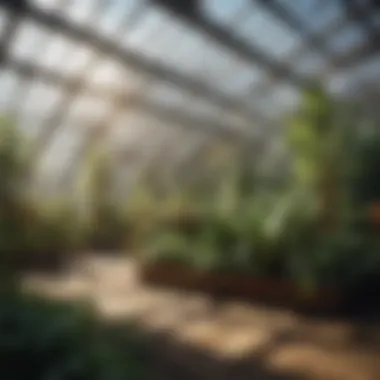
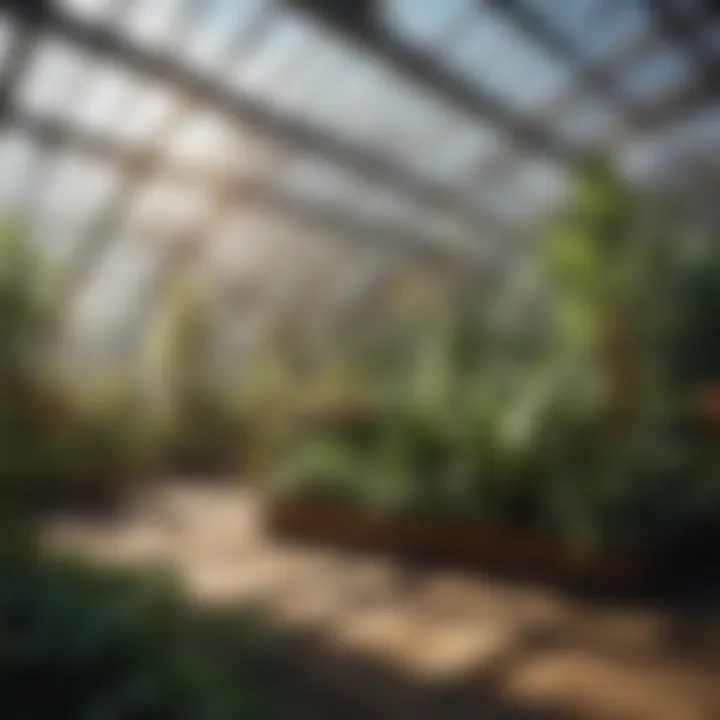
When contemplating the positioning of a greenhouse, evaluating site conditions emerges as a critical element that often determines the long-term success of your gardening goals. This consideration transcends mere aesthetics; it delves into biology and environmental science, shaping how effectively your chosen location will nurture plant growth. Key factors such as sunlight exposure, water drainage, and soil quality are foundational aspects that require careful scrutiny. A misstep in any of these areas could lead to less-than-optimal conditions, affecting plant health and overall yields.
Being proactive about these factors ultimately enhances the greenhouse's effectiveness, leading to higher productivity and healthier plants. Let's unpack these individual components further, illuminating their importance with practical insights and actionable advice.
Assessing Sunlight Exposure
Sunlight is arguably the lifeblood of any greenhouse. Plants rely heavily on photosynthesis, and their ability to grow is inextricably linked to the amount of light they receive. Therefore, when assessing sunlight exposure, it is vital to take into account the orientation of the greenhouse as well as any potential obstructions in the vicinity, such as trees or buildings.
- Southern Exposure: Ideally, a greenhouse should be oriented to face south to receive maximum sunlight throughout the day. This alignment harnesses the sun's path, ensuring consistent lighting for plant growth.
- Shade Analysis: An even more meticulous approach would involve conducting a seasonal shade study. This means observing how shadows shift throughout the day and the year, helping to pinpoint the best spots for installation.
- Time of Year: Consider how different seasons affect sunlight. Your location climates the sun's strength and availability, especially during winter months, so factor in the variations.
In sum, effectively assessing sunlight exposure ensures that your plants receive the energy they need to thrive, maximizing growth potential and harvests.
Water Drainage Considerations
Water management can make or break your greenhouse’s performance. Poor drainage can lead to root rot, mold, and various fungal issues that might devastate plant health. Hence, understanding local drainage patterns is crucial.
- Natural Grade: Evaluate the natural slope of your land. It’s advantageous if the topography allows for water to drain away from the greenhouse.
- Soil Composition: Conduct tests on the soil to determine its texture and composition, such as clay, loam, or sandy soils. Clay soils tend to hold excess moisture, while sandy soils drain better.
- Water Sources: Nearby water sources, like ponds or streams, can influence moisture levels. While proximity could provide irrigation options, it necessitates vigilance against potential flooding.
Adopting effective water drainage solutions, such as installing gravel beds or drainage systems, can help avert water-related issues, enhancing plant vitality and growth.
Soil Quality Evaluation
Proper soil quality is foundational to plant health, and assessing it means examining several elements that together create a fertile environment for growth.
- Nutrient Content: A soil test can reveal nutrient levels— nitrogen, phosphorus, and potassium are crucial elements for plant growth. Understanding the nutrient profile helps you identify what amendments might be necessary for fertile soil.
- pH Levels: Soil pH, ideally between 6.0 and 7.0 for most plants, can significantly influence nutrient availability. If soil is too acidic or alkaline, consider application of lime or sulfur to adjust the pH.
- Organic Matter: Evaluate the organic matter content. Soils rich in organic matter support healthy microbial activity, enhancing nutrient cycling and soil structure.
By conducting a thorough evaluation of soil quality, you lay the groundwork for a thriving greenhouse environment, ensuring that plants receive the balanced nutrients necessary for optimal growth.
In summary, evaluating site conditions encapsulates a holistic approach to greenhouse positioning. By cautiously examining sunlight exposure, water drainage, and soil quality, one can establish a nurturing environment for plant life. Such diligence can bear fruitful results, yielding both healthier plants and increased productivity.
Choosing the Right Location
Selecting the ideal location for a greenhouse is more than just picking a spot on the map. It significantly influences the growth of plants and the overall efficiency of the greenhouse. Hence, careful consideration must be given to its placement, where a combination of convenience, environmental aspects, and potential growth benefits all play a crucial role.
Proximity to Water Sources
When it comes to positioning a greenhouse, having access to water is a top priority. Plants depend on water for life, and the closer your greenhouse is to a reliable water source, the easier it is to maintain optimal hydration levels.
- Reduced Labor: Having a nearby water supply means less time hauling hoses and can reduce physical strain when maintaining soil moisture.
- Irrigation Systems: If you're planning to install an irrigation system, easy access to a water source can be a game-changer. It allows for more efficient setups, including drip systems that conserve water while delivering exactly what the plants need.
- Reliability: Having access to water is critical during dry seasons or drought conditions. Positioning your greenhouse near a pond, well, or municipal water line assures you won’t run dry when your plants need you most.
Access to Pathways and Roads
When you set up your greenhouse in a spot that’s isolated or hard to reach, it can spell trouble down the line. Accessibility is key for various reasons:
- Transportation of Supplies: Whether it’s soil, seeds, or gardening tools, being close to roads or pathways simplifies the logistical side of greenhouse management. You won’t want to be wrestling with heavy bags of fertilizer across a muddy field.
- Maintenance and Upkeep: It’s not just the supplies; access also means you can easily tend to your greenhouse without stressing about how to get equipment in or out. Regular checks and potential repairs become far less of a headache.
- Visitor Access: If you’re considering opening your greenhouse to the public or friends, being on well-traveled routes makes it easier for them to drop by.
Exposure to Winds and Storms
Another critical aspect that may not be immediately visible but can drastically affect your greenhouse is its exposure to weather conditions. Wind and storms can become genuine foes if not considered carefully during placement.
- Windbreaks: When designing the greenhouse location, it’s essential to think about natural windbreaks like trees or buildings that can shield it from harsh winds. Unchecked winds can stress plants and affect temperature control.
- Storm Damage Prevention: In areas prone to storms, positioning your greenhouse in a sheltered spot can mean the difference between destruction and durability. The right location minimizes the risk of physical damage due to heavy rains or strong winds.
- Temperature Control: Wind can also affect internal temperatures as it alters humidity levels. Less exposure means better control over internal climate, leading to healthier plants overall.
A well-considered greenhouse location ultimately enhances not just your setup's efficiency, but its life expectancy as well.
Taking into account proximity to water, access, and protection from external elements will set a strong foundation for a thriving greenhouse. By putting these strategic elements at the forefront of your planning, you can ensure a sustainable gardening endeavor.
Design and Orientation
When it comes to positioning a greenhouse, design and orientation play an instrumental role in maximizing efficiency and plant health. If you envision a greenhouse merely as a structure made of glass and metal, it’s time to broaden that perspective. It’s not just about aesthetics; every world-class greenhouse is a blueprint of advanced engineering and strategic foresight. The design and orientation you choose can influence factors such as light capture, temperature regulation, and even pest control.
Optimal Orientation for Sunlight Capture
To begin, the orientation of a greenhouse is pivotal for ensuring it receives optimal sunlight throughout the day. Ideally, a greenhouse should face southwards in the Northern Hemisphere; this positioning allows the sun’s rays to enter during the crucial hours. However, it’s worth considering the angle of the sun throughout different seasons. For instance, during winter months, the sun is lower in the sky, while summer sees it higher.
- Considerations:
- If the greenhouse is too steep, you might block light from reaching plants on the lower levels.
- Overshadowing from nearby buildings or trees can further reduce light.
The benefits here are clear: by capturing sunlight efficiently, you can reduce heating costs significantly, providing workers and plants alike a much more favorable environment with longer periods of natural light.
Structural Considerations
Turning to structural elements, the design of the greenhouse is as vital as its orientation. Selection of materials and construction methods can either enhance or hinder plant health. For instance, the type of glass impacts the quality of light that permeates the structure. Some materials may lead to excessive heat build-up, which can cause stress to sensitive species.
- Materials to Consider:
- Polycarbonate: Offers excellent insulation and is highly durable, but may block certain UV rays.
- Glass: It allows maximum light but isn’t as efficient in temperature control.
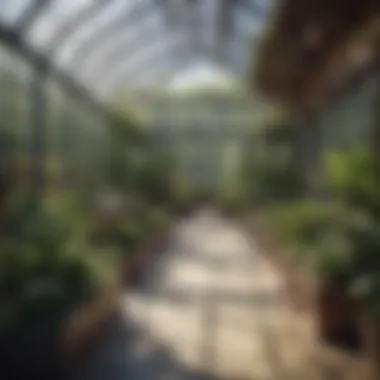
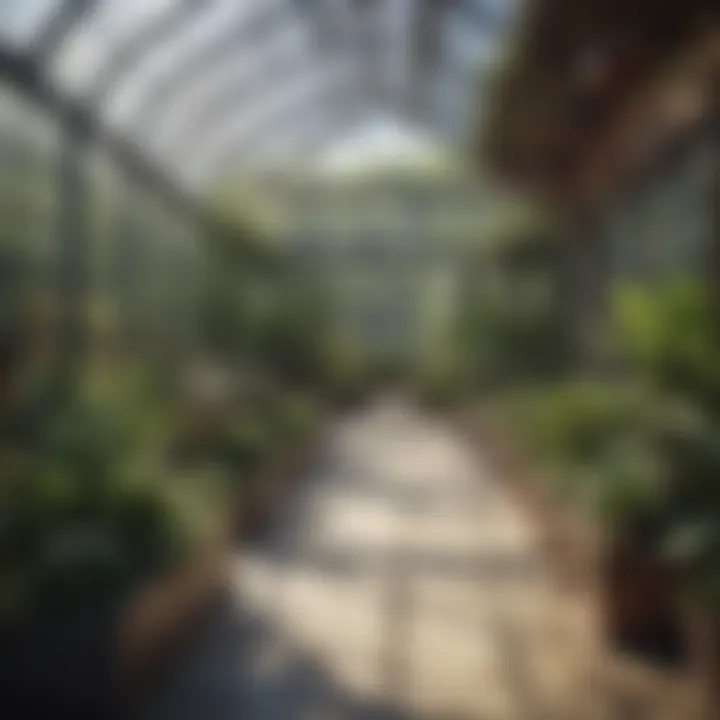
Additionally, ventilation features need to be part of the equation. Ensuring proper airflow helps regulate internal temperatures and reduces humidity, thus limiting fungal growth in plants.
Greenhouse Dimensions and Layout
Next, let’s navigate to dimensions and layout. The size and internal organization of a greenhouse can hugely affect the health of your plants and, ultimately, your yield. Too cramped a layout can stifle growth and lead to increased competition for limited resources. A well-planned greenhouse layout considers several factors:
- Paths and Accessibility: Ensure there’s ample space between rows for easy access during maintenance and harvesting.
- Zoning: Different plants need varied amounts of sunlight and moisture. Group those with similar needs together.
- Nesting of Plants: Taller species can impact sunlight for shorter ones. Adoption of staggered or tiered planting can help.
In summary, a well-thought-out design and orientation of a greenhouse can elevate basic functionality to a level of excellence, ensuring every square foot works hard for optimal growth and efficiency. Ultimately, it’s about creating a conducive microcosm where plants flourish and gardening enthusiasts can cultivate their passion with ease.
Remember, a greenhouse is not just a shelter; it’s an ecosystem waiting to be nurtured.
Microclimate Management
Microclimate management plays a crucial role in the overall success of greenhouse operations. By definition, a microclimate refers to the small-scale climate conditions within a specific area, which can differ significantly from the surrounding environment. This localized climate can profoundly affect plant health, growth rates, and productivity. Effective management of microclimatic factors can lead to optimized growing conditions, thus enhancing both quality and yield of crops.
Understanding and manipulating temperature, humidity, and air circulation can make or break your greenhouse endeavor. For instance, the difference between a thriving collection of heirloom tomatoes and a meek bunch of wilting plants can simply boil down to how well you control these elements.
Utilizing Heat Sinks
Heat sinks serve as an innovative method to regulate temperature in a greenhouse. These are materials or structures that absorb and store heat during the day, slowly releasing it when temperatures drop. Common options include water barrels, concrete slabs, or stones that are placed strategically. For example, filling barrels with water and placing them in sunny areas can capture daytime warmth, which then radiates into the greenhouse during the night, helping to maintain a stable internal temperature.
Benefits of heat sinks:
- Temperature Regulation: Helps in maintaining a consistent heat level, protecting plants from temperature fluctuations.
- Energy Efficiency: Reduces the need for external heating sources, lowering energy costs.
- Improved Growth Rates: Plants thrive in a more stable thermal environment.
Humidity Control Mechanisms
Humidity control is another vital aspect of microclimate management. Excessive moisture can lead to problems such as mold and fungal diseases, while insufficient humidity can cause plants to wilt. Installing humidity sensors and utilizing dehumidifiers or misters as needed can keep moisture levels optimal.
For instance, consider the use of evaporative cooling systems that not only help lower temperatures but also increase humidity. Regularly monitoring humidity levels is key. Too high, and you could face a fungal outbreak; too low, and your plants might suffer from dehydration.
Tips for managing humidity:
- Install hygrometers to keep an eye on moisture levels.
- Ventilate regularly to prevent stagnant air.
- Use humidifiers or misters strategically to boost moisture during dry spells.
Ventilation and Airflow Considerations
Ensuring good airflow is paramount for any greenhouse. Proper ventilation keeps air circulating, preventing hot spots and allowing the escape of excess humidity. Stagnant air can lead to pest infestations and disease, effectively undermining your efforts.
Incorporating passive ventilation through roof vents or adjustable side openings can enhance airflow, especially on hot days. Another strategy is to use mechanical systems like exhaust fans to push out warm air and draw in cooler outside air.
Key points for optimal ventilation:
- Create a cross-breeze by placing vents opposite each other for effective circulation.
- Monitor temperature and humidity to determine when to open or close vents.
- Install fans if natural airflow isn’t sufficient, especially in larger structures.
Remember: A well-ventilated greenhouse not only fosters healthier plants but also minimizes the risk of pests and diseases, providing an edge to your gardening experience.
In summary, mastering microclimate management within a greenhouse is not just beneficial but essential. Engaging in thoughtful practices around heat sinks, humidity control mechanisms, and ventilation can lead to a flourishing greenhouse that yields robust and healthy plants.
Ecological Considerations
Positioning a greenhouse doesn't only revolve around maximizing plant growth; it’s also about how it interacts with its surrounding environment. The ecological consideration is paramount for ensuring the sustainability of your gardening efforts. By being mindful of the ecological impacts of your greenhouse, you create a space that not only supports your plants but also contributes positively to the local ecosystem. This approach enhances biodiversity, optimizes pest management strategies, and supports a healthier growing environment.
Biodiversity Impact
Biodiversity within the area surrounding your greenhouse can have substantial influences on its ecosystem. A rich tapestry of local flora and fauna can enhance the greenhouse’s ability to thrive. For instance, certain plants can be used to attract beneficial insects, like pollinators and predatory bugs, which help in pest control. Planting native species around the greenhouse promotes a balanced ecosystem. This practice not only supports pollinators but also encourages pest predators that can help keep unwanted insects at bay, diminishing the need for chemical interventions.
Integrating these plants creates what some call a "living landscape," which harmonizes your gardening efforts with nature. Some gardeners might consider strategies like permaculture or companion planting, where diverse crop varieties are cultivated together. Not only does this enrich the soil nutritionally, but it offers habitats for a variety of wildlife. Always choose species that naturally thrive in your region, as these will require less maintenance and be more resistant to local pests and diseases.
Pest Management Strategies
Pest management is a crucial aspect of greenhouse maintenance, and ecological considerations can play a significant role here. Cycles of nature can often be harnessed to minimize problems. For example, utilizing integrated pest management (IPM) techniques can lead to sustainable results. This method involves a combination of biological, cultural, and mechanical practices aimed at controlling pests while minimizing harm to the environment.
- Encourage Natural Predators: Introduce beneficial insects such as ladybugs and lacewings to your greenhouse. They consume aphids and other pests, helping keep your plant healthy without resorting to pesticides.
- Companion Planting: Grow pest-repelling plants alongside your primary crops. Flowers like marigolds can deter nematodes while herbs like basil can ward off flies.
- Physical Barriers: Installing nets or screens can block pests from entering the greenhouse while allowing sunlight and air for plants.
"Incorporating ecological strategies for pest management enriches not just the greenhouse but the entire ecosystem, fostering a landscape where nature and nurture coexist."
By weaving these ecological strategies into your greenhouse planning, you can cultivate a thriving green space that respects the delicate web of life around it. Ultimately, a thoughtful approach to ecological considerations not only assures a fruitful yield but contributes to the preservation of the environment.
Legal and Zoning Regulations
Understanding the legal and zoning regulations is crucial when positioning a greenhouse. These regulations can shape not just your construction plans but also the ongoing operational aspects of your greenhouse. They might restrict what type of structures you can build, dictate the size and height limits, and set guidelines for distance from property lines or other structures. Ignoring these regulations could lead to penalties or worse – having to dismantle your greenhouse.
Understanding Local Building Codes
Local building codes play a significant role in the design and construction of any greenhouse. These codes ensure safety standards are met and that structures are built to endure local weather conditions. For instance, hurricanes in coastal areas require strong framing and anchoring specifications, while snowy regions need additional considerations for load-bearing capacities.
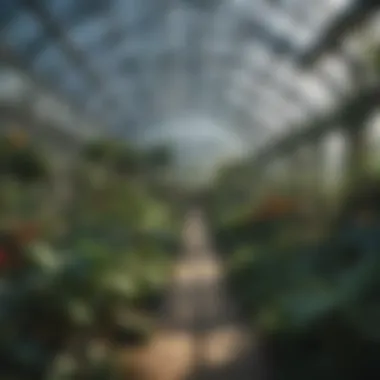
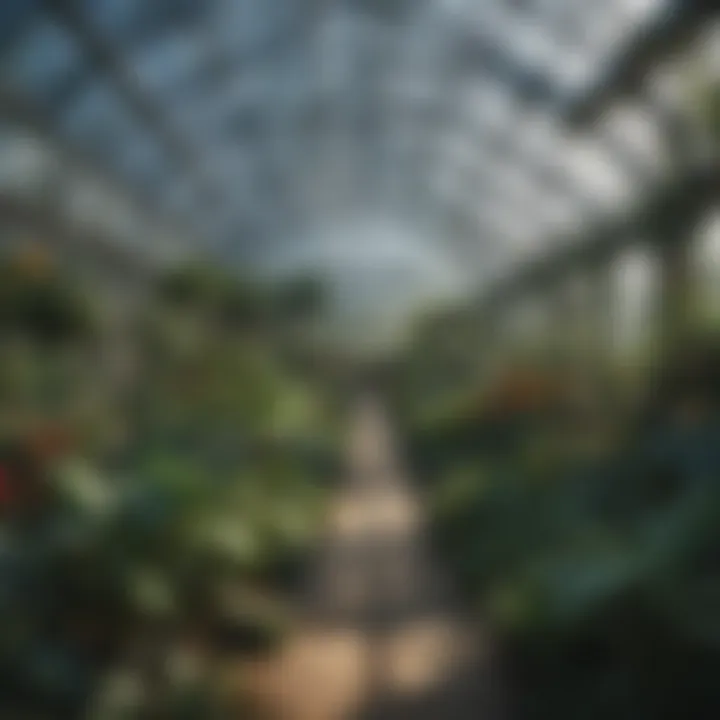
Every locality has its nuances. It's important to either consult a local building official or check your municipality’s website to clarify specific requirements. Here are a few elements that local building codes may address:
- Structure Size and Height: Determine how tall your greenhouse can be and if there are limits on floor area.
- Materials: Some regions may have restrictions on the types of materials that can be used for energy efficiency or fire safety.
- Foundation Requirements: These codes might specify the necessity of a solid foundation to enhance structural integrity.
Tips: Always document consultations with local officials. This not only clarifies your understanding but can serve as proof of your due diligence if any issues arise.
Permitting Requirements
Once you're abreast of the local building codes, the next dimension to explore is the permitting requirements. Securing permits can be a cumbersome process, but it’s essential for lawful construction. These permits often review your building plans to ensure compliance with zoning laws, environmental regulations, and safety standards.
The need for a permit typically depends on:
- Size of the Structure: Larger greenhouses are more likely to require permits than smaller ones.
- Location: If you're positioned close to protected areas or have extensive modifications, stricter rules might apply.
- Type of Greenhouse: A structure intended for commercial production can face different regulatory scrutiny than a simple hobby greenhouse.
Getting the wrong permissions—or none at all—could cost a pretty penny in fines or remediation efforts.
"Investing time in understanding legal and zoning regulations can save you headaches down the line. Navigating this realm from the outset often turns out to be a priceless investment in your greenhouse journey."
In summary, while digging into local regulations may feel tedious, it’s an unavoidable step in positioning your greenhouse effectively. Ignoring them won't just cast a shadow over your plans but could also impact the lifespan and operational success of your green paradise.
Financial Considerations
When it comes to establishing a greenhouse, financial considerations form a crucial backbone of the decision-making process. The initial investment, as well as ongoing costs, profoundly impact not only the viability of your project but also its long-term success. Allocating a budget smartly can make the difference between a thriving greenhouse and a financial headache. This section breaks down a few key components essential for making sound financial choices related to greenhouse positioning.
Budgeting for Construction and Maintenance
Crafting a detailed budget for the construction and subsequent maintenance of a greenhouse is akin to laying a strong foundation—it sets the stage for everything that follows. Here are the main cost components to keep in mind:
- Initial Construction Costs: These include materials, labor, and any necessary equipment. Depending on your choice of structure (polycarbonate, glass, or plastic), costs may vary significantly. Aim for a balance between durability and cost-effectiveness.
- Utilities and Energy Expenses: Greenhouses can be energy-intensive requiring heating, cooling, and lighting. These utility bills can add up quickly, so considering energy-efficient systems may save you a bundle down the line.
- Watering and Irrigation Systems: A robust irrigation system is vital. Whether you're opting for drip irrigation or a simpler manual setup, budget for both the installation costs and the ongoing maintenance.
- Pest Control and Fertilizers: Allocating funds for organic or conventional pest control and fertilizer needs is essential. This can vary significantly based on what you're cultivating.
By assessing each of these factors carefully and estimating costs as realistically as possible, you can prevent unexpected financial strain as you proceed.
Cost-Benefit Analysis of Positioning
Evaluating the economic feasibility of your greenhouse positioning involves a thorough cost-benefit analysis. This means weighing the expenses associated with your greenhouse against the anticipated gains.
- Increased Yield Potential: Investing in a well-positioned greenhouse can lead to higher yields due to optimal sunlight exposure and climate control. This increase in production can yield more profit, especially if you're growing specialty crops or flowers.
- Enhanced Operational Efficiency: A strategically placed greenhouse can reduce operational challenges. For instance, proximity to utility hookups or water sources decreases transport costs and simplifies maintenance.
- Resale Value: Everyone loves real estate potential—the right positioning can significantly boost the value of your property. A professionally constructed, well-situated greenhouse can be a significant selling point if you ever choose to move.
Balancing these elements is essential. Through a quantitative lens, align your expectations against realistic projections of yield and profitability.
"Financial planning is like gardening; it requires patience, foresight, and regular tending. To reap a bountiful harvest, one must invest wisely in the planting of seeds today."
Future-Proofing Your Greenhouse
Positioning a greenhouse isn't just a decision that needs to be made in the moment; it’s a long-term strategy that can yield benefits for years to come. In today's world, where environmental conditions can be unpredictable, future-proofing your greenhouse has become essential. This concept not only ensures that your greenhouse will function effectively now but also adapts to potential changes that may occur down the road. Proper foresight in this area can save you time, effort, and headaches as conditions evolve.
Adapting to Climate Change
Climate change is an unavoidable reality that is affecting all of us. For gardeners and greenhouse enthusiasts, this means that understanding local weather patterns and potential shifts are crucial. Here’s why adapting to climate change matters:
- Long-term Viability: Greenshouses that are built without consideration for climate change may face untold challenges—unexpected temperature swings or shifts in precipitation patterns can compromise your garden.
- Selection of Resilient Plants: Knowing what plants will thrive under changing conditions is key. Opt for species that are hardier and better suited for fluctuating temperatures.
- Innovative Technologies: Look into using technologies such as temperature-regulating materials or automated systems for watering and humidity control, which can adjust to changing needs.
Here’s a practical tip: installing a weather station can help you track local conditions and make informed decisions about plant care when the weather doesn’t play nice.
Sustainable Practices
Sustainability doesn’t just help safeguard the environment; it also contributes to the resilience of your greenhouse. Being mindful about your practices now lays a strong foundation for the future. Here are ways to bring sustainability into your greenhouse:
- Water Conservation: Implement rainwater collection systems, or apply drip irrigation techniques to make the best use of this vital resource.
- Solar Solutions: Using solar panels not only reduces your carbon footprint but also can provide affordable energy solutions for light and heating—allowing for efficient explanations.
- Crop Rotation and Companion Planting: These methods enrich the soil and maintain its health, which is crucial especially as environmental conditions shift.
“Sustainable practices today mean the world will be a better place for your plants tomorrow.”
Future-proofing your greenhouse is not merely about reacting to change. Rather, it’s about anticipating and preparing for it. By thoughtfully considering climate adaptation and implementing sustainable practices, you can create a thriving environment for your plants, regardless of what the future holds.
Ending
When it comes to positioning a greenhouse, wrapping your head around the various considerations isn’t just a minor footnote in the planning process; it’s fundamental to the overall success of your gardening endeavors. The strategic placement can significantly impact everything from plant health to energy efficiency, thus impacting the viability of your horticultural pursuits.
Recap of Key Considerations
So, let’s quickly run through some key points we’ve covered:
- Sunlight Exposure: Understanding where to catch the sun’s rays can mean the difference between lush growth and struggling plants. Choosing a location that maximizes light is crucial.
- Climate Control: The weather doesn’t play favorites. Knowing how to position your greenhouse to mitigate temperature extremes is a game changer. Consider aspects like natural windbreaks and heat sinks.
- Accessibility: A well-placed greenhouse is not just functional but also easy to reach. Make sure it's accessible for maintenance, harvesting, and daily tasks.
- Environmental Interactions: Take note of the surrounding flora and fauna. Pests and beneficial insects might come into play here, along with the potential for cross-pollination.
- Legal Regulations: Forgetting about zoning laws can spell disaster. Always check local building codes beforehand to dodge setbacks in construction.
These aspects are not just trivial details; they weave together to create the framework of a thriving greenhouse that can provide you with a bounty of fresh vegetables or stunning floral displays.
Encouragement for Informed Choices
Navigating the complexities of greenhouse placement might seem daunting, but it’s essential to take the journey one step at a time. Equip yourself with knowledge, seek guidance from experienced gardeners, and take your time with each decision. The magic of horticulture lies in the learning process.
The choices you make today can create lasting impacts for your plants and your enjoyment of gardening. So, whether you’re an aspiring botanist or a casual green thumb, spend a little extra time figuring out how to position your greenhouse effectively. In the end, investing that thoughtfulness will pay off in healthier plants and a more fulfilling gardening experience. Remember, every great gardener started with careful planning and a willingness to learn from every sunbeam and sprout.
"In gardening, the rewards are as abundant as the effort you’re willing to put in; choose wisely, and flourish."







